How To Set Bpm In Ableton
21. Automation and Editing Envelopes
Ofttimes, when working with Live's mixer and devices, you volition desire the controls' movements to go part of the music. The move of a control across the vocal timeline or Session clip is called automation; a control whose value changes in the course of this timeline is automated. Practically all mixer and device controls in Alive can be automated, including the vocal tempo.
21.ane Recording Automation in Arrangement View
Automation can exist recorded to the Organization View in 2 ways:
- past manually changing parameters while recording new material directly into the Arrangement.
- by recording a Session View performance into the Arrangement (see seven.5), if the Session clips incorporate automation.
During Session-to-Organisation recording, automation in Session clips is ever recorded to the System, as are whatsoever manual changes to parameters in tracks that are existence recorded from the Session.
When recording new material directly to the Arrangement, the Automation Arm push button determines whether or not manual parameter changes volition be recorded.

When Automation Arm is on, all changes of a control that occur while the Command Bar's Arrangement Record button is on become Arrangement automation. Endeavor recording automation for a control; for instance a mixer book slider. After recording, play back what yous accept just recorded to run across and hear the effect of the control movement. Yous will observe that a little LED has appeared in the slider pollex to indicate that the control is at present automated. Try recording automation for track panning and the Track Activator switch too; their automation LEDs announced in their upper left corners.

21.2 Recording Automation in Session View
Automation tin can also be recorded to Session View clips. Here is how it works:

- Enable the Automation Arm push button to prepare for automation recording.
- Actuate the Arm push for the tracks onto which you want to record. Clip Record buttons will appear in the empty slots of the armed tracks.
- Click the Session Record button to brainstorm recording automation.
It is too possible to record automation into all playing Session clips, regardless of whether or not they are in armed tracks. This is done via the Session Automation Recording switch in the Record/Warp/Launch Preferences.

This allows y'all to, for example, overdub Session automation into an existing MIDI clip without as well recording notes into the clip.
Any automation in Session View becomes runway-based automation when clips are recorded or copied into Arrangement View.
21.2.ane Session Automation Recording Modes
The automation recording beliefs differs depending on how you adapt parameters while recording. When using the mouse, recording stops immediately when yous permit go of the mouse push button. This is referred to in some editing applications as "touch" behavior. When adjusting parameters via knobs or faders on MIDI controllers, recording will proceed as long as you lot suit the controller. When you let become, recording will go on until the stop of the clip'southward loop and so volition "punch out" automatically. This is known as "latch" behavior in some applications.
21.three Deleting Automation
To delete all automation information, right-click(Win) / CTRL-click(Mac) on an automatic control to open up its context bill of fare and select Delete Automation, or press the CTRL-Backspace(Win) / CMD-Backspace(Mac) shortcut keys. The automation LED disappears, and the control'due south value stays constant across the entire Arrangement timeline and in any Session View clips. You lot can as well delete selected portions of automation by editing breakpoint envelopes (see 21.five).
21.4 Overriding Automation
In practice, you lot will often want to try out new control moves without overwriting existing automation data in the Arrangement. Well, nothing is forever in the earth of infinite Disengage (see 10.4.ane), but information technology's easy to disable a control's automation temporarily to avoid overwriting existing data: If you lot change an automated control's value while not recording, the automation LED goes off to indicate the command'due south automation is inactive. Any automation is therefore overridden past the current manual setting.
When ane or more of the automated controls in your Live Set up are not active, the Control Bar'due south Re-Enable Automation button lights up.

This push serves two purposes. Information technology reminds yous that the current country of the controls differs from the state captured in Session clips or the Arrangement, and you lot can click on it to reactivate all automation and thereby return to the automation state as it is written "on tape."
You tin can also re-enable automation for just one parameter via the Re-Enable Automation option in the correct-click(Win) / CTRL-click(Mac) context card for that parameter. And in the Session View, yous tin re-enable overridden automation by simply relaunching a clip that contains automation.
21.v Cartoon and Editing Automation
In the Organization View and in Session View clips, automation tin be viewed and edited as breakpoint envelopes.
Hither is how automation editing works in the Arrangement:
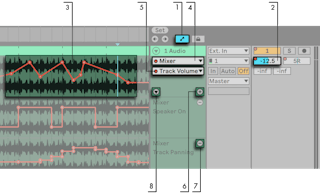
- To prove automation envelopes, enable Automation Mode by clicking the
 toggle push to a higher place the runway headers, or using the A shortcut to the View menu item. Note that y'all can disable Automation Mode by pressing the
toggle push to a higher place the runway headers, or using the A shortcut to the View menu item. Note that y'all can disable Automation Mode by pressing the  toggle button or A shortcut key once more.
toggle button or A shortcut key once more. - Clicking on a track's mixer or device controls volition display this control'southward envelope on the clip track.
- Envelopes announced in the track'southward principal automation lane, "on top of" the audio waveform or MIDI brandish. (This is useful for lining up breakpoints with the track'due south audio or MIDI content.) An envelope'southward vertical axis represents the command value and the horizontal axis represents time. For switches and radio buttons, the value axis is "discrete", pregnant that it operates with non-continuous values (eastward.g., on/off).
- The Device chooser either selects the track mixer, one of the track's devices, or "None" to hibernate the envelope. It also provides you with an overview of which devices actually have automation by showing an LED side by side to their labels. You tin can brand things clearer even so by selecting "Show Automatic Parameters Simply" from the lesser of the chooser.
- The Automation Control chooser selects a command from the device called in the Device chooser. The labels of automatic controls take an LED.
One time an envelope has been selected on the track, several new buttons appear:
- The
 push moves the envelope into its own automation lane below the clip. Y'all can and so select another automation parameter from the choosers to view it simultaneously. Belongings ALT(Win) / CMD(Mac) while pressing the
push moves the envelope into its own automation lane below the clip. Y'all can and so select another automation parameter from the choosers to view it simultaneously. Belongings ALT(Win) / CMD(Mac) while pressing the  button moves the selected envelope, as well equally all automated envelopes, into their own automation lane(s) below the clip. If the Device chooser is set to "None", this button will exist subconscious.
button moves the selected envelope, as well equally all automated envelopes, into their own automation lane(s) below the clip. If the Device chooser is set to "None", this button will exist subconscious. - The
 push hides its respective automation lane. Notation that hiding a lane from view does non deactivate its envelope. Belongings ALT(Win) / ALT(Mac) while clicking the
push hides its respective automation lane. Notation that hiding a lane from view does non deactivate its envelope. Belongings ALT(Win) / ALT(Mac) while clicking the  button removes the selected automation lane, besides every bit whatever subsequent automation lanes in that track.
button removes the selected automation lane, besides every bit whatever subsequent automation lanes in that track. - The
 toggle appears when an envelope is moved into its own automation lane. This toggle lets you testify or hibernate all boosted automation lanes.
toggle appears when an envelope is moved into its own automation lane. This toggle lets you testify or hibernate all boosted automation lanes.
Clicking right-click(Win) / CTRL-click(Mac) on an automation lane header opens a context menu with additional options for viewing envelopes. This context menu besides contains commands to chop-chop clear all automation envelopes for the track or any of its devices.
You tin employ the left arrow key to navigate from an automation lane to the principal track, this will fold all automation lanes too. Using the left and right arrow keys on a chief track volition fold/unfold its automation lanes.
Automation editing for Session View clips is covered in detail in the Clip Envelopes chapter (see Chapter 22).
21.5.one Drawing Envelopes
With Depict Mode enabled, you can click and drag to "draw" an envelope curve.

To toggle Draw Mode, select the Draw Manner option from the Options menu, click on the Control Bar's Draw Mode switch, or press B. Holding B while editing with the mouse temporarily toggles Describe Mode.
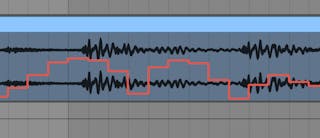
Cartoon creates steps as wide as the visible grid, which you can modify using a number of handy shortcuts (meet half-dozen.9). Holding down the Shift modifier while dragging vertically allows you to suit the automation value of a footstep at a finer resolution.
For freehand drawing, y'all tin hide the filigree using the Snap to Grid Options menu entry or the CTRL-4(Win) / CMD-iv(Mac) shortcut. To temporarily enable freehand drawing while the grid is shown, hold down ALT(Win) / CMD(Mac) while drawing.
21.5.2 Editing Breakpoints
With Depict Style off, the envelope display looks and works differently. The line segments and the breakpoints connecting them get draggable objects. Clicking and dragging in the envelope'south background defines a selection. Hither'south how editing breakpoints works:
- Click at a position on a line segment to create a new breakpoint in that location.
- Double-click anywhere in the envelope display that is not on a line segment, to create a new breakpoint there.
- Click on a breakpoint to delete it.
- To help you edit breakpoints more than speedily, automation values are shown when you create, hover over, or elevate a breakpoint. Notation that when hovering over or dragging a selected line segment, the automation value shown will stand for to the breakpoint closest to the cursor.
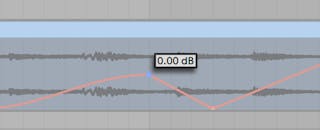
- Click and drag a breakpoint to move information technology to the desired location. If the breakpoint you are dragging is in the electric current selection, all other breakpoints in the selection volition follow the motion. When dragging a breakpoint, a sparse black vertical line will appear to aid you see where your breakpoint is positioned in relation to the grid lines.
- Click right-click(Win) / CTRL-click(Mac) on a breakpoint and choose Edit Value from the context menu. This allows you lot to set up an exact value in the editable field using your computer keyboard. If multiple breakpoints are selected, they will all exist moved relatively. Similarly, you can also create new breakpoints at an exact value by clicking correct-click(Win) / CTRL-click(Mac) on a preview breakpoint and choosing the Add together Value command.
- Click nearly (but not on) a line segment or hold Shift and click directly on a line segment to select it. With the mouse push button held down, drag to movement the line segment to the desired location. If the line segment you are dragging is in the current time pick, Live volition insert breakpoints at the option's edges and the unabridged segment volition movement together.
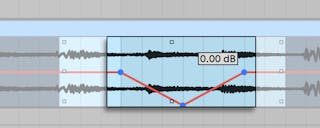
- Breakpoints created shut to a grid line will automatically snap to that line. Concur down the ALT(Win) / CMD(Mac) modifier while dragging horizontally to bypass grid snapping.
- Breakpoints and line segments will snap to time positions where neighboring breakpoints exist. You can remove a neighboring breakpoint past continuing to drag a breakpoint or line segment "over" it horizontally.
- When moving a line segment or breakpoint, hold Shift while dragging to restrict motion to either the horizontal or vertical axis.
- Holding downward the Shift modifier while dragging vertically allows you to arrange the breakpoint or line segment value at a finer resolution.
- Hold ALT(Win) / ALT(Mac) and elevate a line segment to curve the segment. Double-click while property ALT(Win) / ALT(Mac) to return the segment to a direct line.

21.five.3 Stretching and Skewing Envelopes
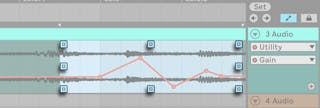
When hovering over a time option, handles appear around the outer edges of the selection. Clicking and dragging these handles allows you lot to transform the selected automation in the following ways:
- Dragging the meridian and bottom heart handles lets you stretch the automation forth the vertical axis. While dragging, a rectangle indicates the amount of stretching. The rectangle will snap to upper and lower boundaries and when its corners intersect. Holding Shift allows yous to finely adjust the amount of stretching. Dragging across the boundaries will clip the envelope.
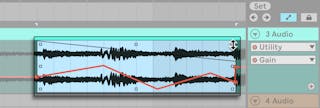
- Dragging the left and right center handles lets y'all stretch the automation along the horizontal axis. Dragging over existing breakpoints exterior the time selection will remove them. If you hold Shift while stretching, these breakpoints will be moved in proportion to the movement of the handle. Hold down the ALT(Win) / CMD(Mac) modifier while dragging horizontally to featherbed grid snapping.
- Dragging any of the corner handles lets you skew the automation. While dragging, a rectangle indicates the degree of skewing. The rectangle volition snap to upper and lower boundaries and when its corners intersect. Belongings Shift allows you lot to finely adjust the amount of skewing.
- Dragging a handle while holding ALT will mirror the movement in the contrary handle, as if you were dragging them both simultaneously in opposite directions.
21.5.4 Simplifying Envelopes
If your automation envelope has a large amount of breakpoints, due east.k., after recording automation, the Simplify Envelope control can exist quite useful. Simplify Envelope calculates the optimal number of breakpoints needed to represent the selected automation envelope, and removes any unnecessary breakpoints, replacing them with direct lines or curved segments where appropriate.

Make a fourth dimension pick on the automation you wish to simplify, and choose Simplify Envelope in the right-click(Win) / CTRL-click(Mac) context carte du jour.
21.5.5 Inserting Automation Shapes

Automation shapes can help y'all quickly create complex rhythmic automation patterns, as well as more subtle, ho-hum-paced movements similar swells, builds and drops.
There are several predefined automation shapes that you can apply to a time option. To insert an automation shape, right-click(Win) / CTRL-click(Mac) on a time pick and choose a shape from the context carte.
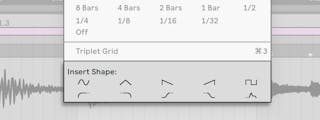
There are two types of automation shapes. In the top row of available shapes, yous'll discover several common waveforms: sine, triangle, sawtooth, inverse sawtooth and square. When inserted, these shapes will be scaled horizontally to the time selection and vertically to the automated parameter range. If there is no time option, the shapes volition be scaled horizontally to the current filigree size.
In the bottom row of available shapes are ii sets of ramps, and an ADSR shape. These shapes deport slightly differently than those on the top row. When inserted, they volition link up to the value of the automation before or after the selection, as indicated by their dotted line.
21.5.6 Locking Envelopes
When moving System View clips, Live normally moves all automation with the clip. Sometimes, you might desire to lock the envelopes to the song position rather than to the clips, and the Lock Envelopes switch does merely that.
You tin also choose to lock envelopes from the Options carte.

21.5.7 Edit Menu Commands
When working with automation data in the Arrangement View, several Edit menu commands deport differently depending on whether or not your selection is within the prune track or its automation lanes.
Cut, Copy, Duplicate or Delete commands applied to an envelope selection within a single lane will simply utilize to this envelope. The clip itself and other automation that occurs in that fourth dimension option will be unaffected. You tin also work with envelopes in multiple lanes simultaneously.
If you want your edits to utilize to both the clip and all of its associated envelopes, ensure the Lock Envelopes switch is disabled and apply edit commands to a selection in the prune track.
Annotation that Live allows you to copy and paste envelope movements not only from i point in time to another, but also from one parameter to another. Since the parameters may be completely unrelated, this tin take unexpected (but possibly interesting) results.
21.5.viii Editing the Tempo Automation
The power to dynamically stretch and compress audio to track whatever tempo or tempo variation is one of Live's specialties. In Alive, the song tempo is but another automated control.
To edit the song tempo envelope, unfold the Master track in Arrangement View, choose "Mixer" from the top envelope chooser and "Vocal Tempo" from the bottom one.

When adjusting the tempo envelope, you lot might want to scale the value axis brandish, which is the role of the ii value boxes beneath the envelope choosers: The left box sets the minimum, and the right box sets the maximum tempo displayed, in BPM.
Annotation that these 2 controls also decide the value range of a MIDI controller (encounter 29.1) assigned to the tempo.
Source: https://www.ableton.com/answers/changing-the-tempo-for-a-selected-part-of-a-song

0 Response to "How To Set Bpm In Ableton"
Post a Comment